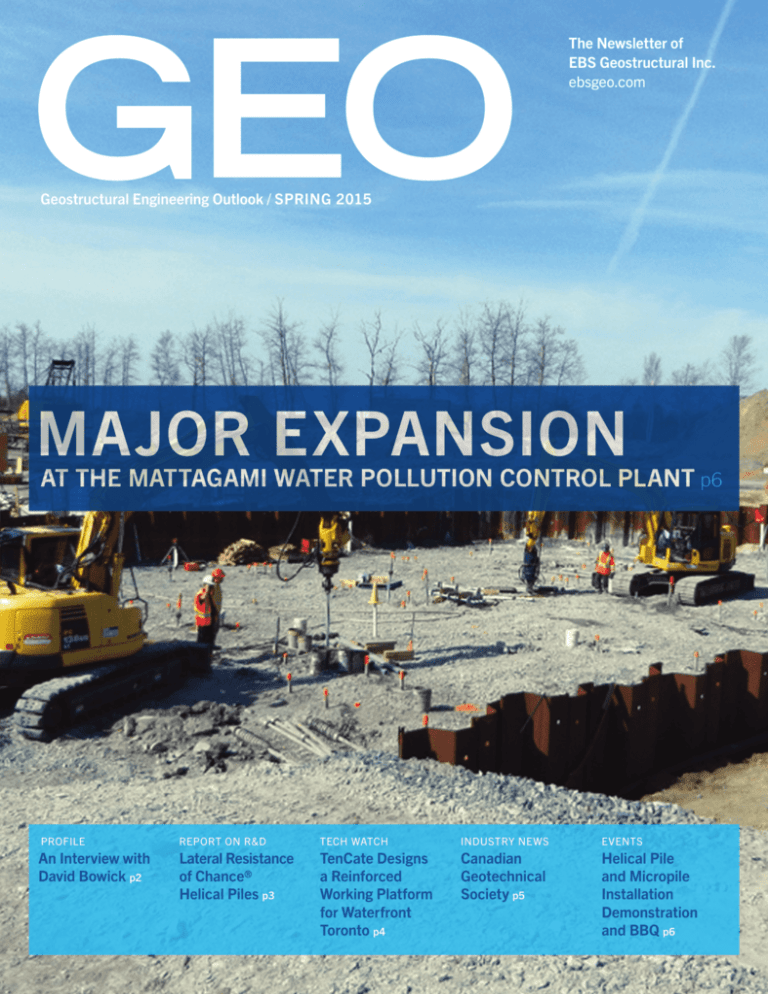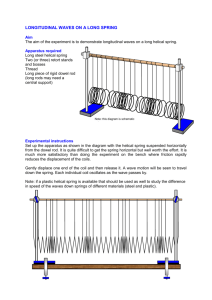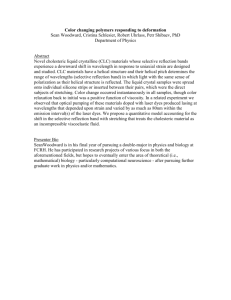
The Newsletter of
EBS Geostructural Inc.
ebsgeo.com
Geostructural Engineering Outlook / SPRING 2015
MAJOR EXPANSION
at the Mattagami Water Pollution Control Plant p6
PROFILE
report on r&d
Tech Watch
industry news
EVENTS
An Interview with
David Bowick p2
Lateral Resistance
of Chance®
Helical Piles p3
TenCate Designs
a Reinforced
Working Platform
for Waterfront
Toronto p4
Canadian
Geotechnical
Society p5
Helical Pile
and Micropile
Installation
Demonstration
and BBQ p6
Profile
Company
Blackwell Structural Engineers
David Bowick
P. Eng.
LocationS
Toronto, Ontario
Waterloo, Ontario
President
What attracted you to the field of structural
engineering? I was drawn to structural
engineering because it seemed to be a profession
that would allow me to use the creative right
side of my brain as well as the algorithmic left
side. It seemed to be the crossover between
architecture and engineering. This has proven
to be quite true for me – I feel like I’ve had more
opportunities to make greater contributions to
great architecture as an engineer than I likely
would have had if I had been an architect.
What trends have you seen in the
structural engineering field over your
career and what has changed the most?
The biggest trend that I have seen is a trend
towards increasing complexity. This is
certainly true in terms of building form.
Computer modelling, analysis, design and
documentation have removed most barriers
from the design profession. Increasing
complexity in structures has precipitated the
need for many new solutions to problems, so
our engineering toolbox is much larger with
more solutions to more specific problems.
At the same time, as structures are becoming
more complex, building codes are becoming
more complex in every discipline. As
well, contract models are becoming more
complex. Traditional stipulated sum contracts
are becoming the exception with project
management, construction management,
design build, P3 and other models becoming
more common.
In your opinion, what are the greatest
challenges facing this field? Increasing
complexity is generating increasing risk.
Code development is seduced and blinded by
the potential for increased precision, without
necessarily recognizing that increased
precision does not mean increased accuracy.
Engineers can become lost in the complexity
and the vast amounts of data and lose a
feel for the behaviour of structures which
increases risk. Computers allow engineers to
generate very precise and highly inaccurate
2 Spring 2015
solutions. We also need to develop new ways
of describing complex structures where
conventional orthogonal plans and elevations
fail to tell the story. Structures not adequately
described expose everyone from owners to
contractors and consultants to financial risk.
What are the top three projects you worked
on and why? We recently completed the
Goldring Centre for High Performance Sport
at U of T – a four storey athletic centre spanning
54 m over a below grade basketball stadium.
This was an extraordinary project for me for
being architecturally wonderful as well as
requiring many innovative technical solutions.
It is also the pinnacle of a long, great tradition
of athletic projects at Blackwell and allowed us
to work with our old great friends at MJMA and
new friends at Patkau.
1
The Whitecap Waterfront Pavillion in Kenora
Ontario, on the shore of Lake of the Woods, while
not huge, was an exciting project because it pulled
us into a whole new territory of engineering –
tensile fabric structures. Understanding how
to work with tension, prestress, non-linearity,
complex geometry and large deformations has
helped us design many subsequent projects
from the Sisters of St. Joseph Convent, to the
Goldring Centre and the facade of the Lassonde
Engineering School at York by ZAS.
2
The Perimeter Institute for Theoretical Physics
was extremely important for us because it was
a break out project. It was one of the largest
institutional projects constructed around that
time as well as being one of the most significant.
It anchored downtown Waterloo and led to more
great architecture to follow, such as the Knox
Church by BSN and the Centre for International
Governance Innovation by KPMB.
3
Article continued on page 3
1. University of Toronto’s Goldring Centre for High Performance
Sport, 2015, MJMA & Patkau Architects
2. Prince Arthur’s Landing, Thunder Bay, 2011, Brook McIlroy
3. St. Catharines Aquatic Centre, 2012, Perkins+Will
4. Residence for the Sisters of St. Joseph of Toronto, 2014
Shim-Sutcliffe Architects
Geostructural Engineering Outlook
4
The Newsletter of EBS Geostructural Inc.
PROFILE CONTINUED //
By David Bowick P.Eng.
How do you see structural engineering
changing in the future? I think structural
engineering will evolve to respond to the
increasing complexity of structures, with
increased reliance on computer modelling
and documentation. This is already happening.
I also see the profession beginning to fracture
into sub-disciplines. The skills that it takes
to design and detail a condominium are
very different than those required to design
a geometrically complex gallery or museum
project. The delivery model and the level
of resolution are different.
With increasing structural complexity, and
increasing focus on risk management, more
structures need to be “engineered” – validated
in advance and demonstrated by calculation
and simulation. This will result in new
engineering disciplines, the way the discipline
of building envelope consulting emerged in the
80’s and 90’s. Until these new disciplines gain
a toe hold as disciplines in their own right, the
existing engineering disciplines will specialize to
fill those gaps.
What would you like to tell everyone about
yourself that not many people know? I think
I want people to know that I, and Blackwell as
a firm, are tackling these complex challenges
head on. It is one of our toughest challenges and
greatest opportunities. We are investing heavily
in software (of course) but also in fostering a
culture of engagement that leads to the kind of
insight and experience that can really support
our design community.
What are the toughest challenges you have
encountered in your career? Our toughest
challenges are always financial. The demands
on our profession are growing exponentially.
To embrace a problem and always try to find
the best solution to the problem, rather than
redefining the problem to suit an existing
solution, is time consuming and costly. It is
much more difficult to carve a round peg than
pull a square one out of the box. We believe
that in the fullness of time the value will be
demonstrated and we will, ourselves and as a
profession, be remunerated for those efforts,
but it is a long journey. G
Lateral Resistance of Chance Helical Piles
by Hesham El Naggar P.Eng., B.E.Sc., M.E.Sc., Ph.D.
The University of Western Ontario, Professor and Research Director,
Geotechnical Research Centre, Department of Civil and Environmental Engineering
The Reinforced Helical Pulldown Micropile (RHPM)
consists of a helical pile installed with a grout
column surrounding the pile central shaft along
the extensions as shown in Figure 1. The grout mix
contains steel fibres that are added during grout
mixing. The addition of steel fibres provides ductility
to the RHPM and therefore increases energy
dissipation to the material, which are favourable
characteristics for structures to resist earthquake
and wind loads. El Sharnouby and El Naggar1
conducted a field study on the lateral monotonic and
cyclic behaviour of steel fibre-reinforced RHPM.
In order to assess the grout shaft contribution, one
helical pile without a grout shaft was also tested. The
results presented in Figure 2 show that the grout
shaft significantly improves the helical pile lateral
150 mm Ø Grout Column
Surrounding Helical Extension
performance, i.e., resisting up to 80 kN of lateral
load compared to less than 10 kN for plain piles.
In addition, the piles showed significant increase
in its ductility (no observed failure up to 75 mm
displacement – 50% of pile diameter). The area of the
hysteretic loops demonstrates the energy dissipation
in each load cycle. Two-way cyclic loading resulted
in overall degradation in pile stiffness and capacity.
However, degradation was from the formation
of gaps rather than soil stiffness degradation.
The results suggest that the reinforced helical
pulldown micropile is a viable deep foundation
option for lateral monotonic and two-way cyclic
loading applications. G
Chance® Helical Extensions
Chance® Lead Section 200, 250
and 300mm Ø Helical Plates
El Sharnouby, M. and El Naggar, M.H. 2011. Monotonic and Cyclic Lateral
Full-Scale Testing of Reinforced Helical Pulldown Micropiles. Proceedings of
36th Conference on Deep Foundations, Boston, October 18–21.
1
Figure 1
Figure 2
a
Figure 1: RHPM test pile profile after installation
b
c
Figure 2: a ) Lateral load displacement curve for RHPM; b) Cyclic lateral load vs. displacement for RHPM;
c) Lateral load displacement for 1st and last cycle of 15 kN; and d) Cyclic lateral load displacement for RHPM and plain pile at last cycle of loading
d
TenCate Designs a Reinforced Working
Platform for Waterfront Toronto
By René LaPrade P. Eng.
Engineering Business Manager Eastern Canada, TenCate
US development giant, Hines, in partnership with Canada’s largest
condo developer, Tridel, are building the Bayside Development project
in Toronto. This $1.1 billion community will be located on Toronto’s
easterly waterfront of Lake Ontario. The development, expected to
take at least a decade to complete, is being touted as the largest privatesector development in Waterfront Toronto’s efforts to revitalize the
city’s lakefront.
The TenCate engineers correlated information from available borehole
logs into a reinforced slope stability analysis using Mirafi® HP770PET as
the reinforcement geosynthetic to design a reinforced working platform.
This geotextile is composed of high tenacity polypropylene yarns in the
drill rig direction and high tenacity polyester multifilament yarns in
the cross-machine direction. It was chosen for its high tensile strengths,
especially in the cross-drill rig direction.
The East Bayside portion of the project will be built on up to 9 m of very
weak fill material that has SPT counts under 5. The existing fill varies
widely from loose wet silty sand, to partially decomposed organic matter,
to the occasional brick fragments. It is economically unfeasible to remove
all this fill, the plan was to install a series of deep caissons for the support
of the future condominium structures.
The original slope stability analysis took into account a thin, stiffer crust
of previously compacted fill (friction angle 8°, cohesion of 50 kPa) overlying
a very soft subsoil (friction angle 4°, cohesion of 10 kPa). The reinforced
design was 1.2 m of granular material overlying the reinforcement, within
the limit set by the water table governed by adjacent Lake Ontario.
In order to drive their piles, the contractor required a working
platform on which to operate a 100-ton drill rig. Additionally, it was
only possible to remove a maximum of 1.5 m of fill due to the existing
high water table.
Installation of granular fill on top of the Mirafi HP770PET geotextile
The Newsletter of EBS Geostructural Inc.
On site, Mirafi® HP770PET performed even better than originally
anticipated. 600 mm of recycled concrete was placed on the fabric in two
lifts. After the piles were driven, the Mirafi® HP770PET was removed to
allow the contractor to pour their foundations. G
Drill Rig Supported by granular fill and Mirafi geotextile
Geostructural Engineering Outlook
Spring 2015 4
canadian geotechnical society –
SOUTHERN ONTARIO SECTION
by Dino Vito M.A.Sc., P. Eng.
President, EBS Geostructural Inc.
The Canadian Geotechnical Society (CGS)
is the premier organization for geotechnical
engineers and geoscientists in Canada and
is dedicated to advancing knowledge and
creating opportunities for the sharing of
information by practitioners in a broad range
of geotechnical disciplines.
With over 1,200 members across Canada and
around the world, the CGS is a driving force
in the geotechnical profession, providing
opportunities for members to:
•Upgrade their skills through local, regional
and national professional development
offerings
•Present and publish results of research,
design and construction in the field of
geotechnology and related geoscience
•Meet, exchange views and experiences,
and establish networks on a discipline and
geographical basis
Formed in 1947, the CGS is a registered
not-for-profit organization under federal
statute and is a constituent society of the
Engineering Institute of Canada (EIC).
The Canadian Geotechnical Society Southern
Ontario Section (CGS-SOS) Toronto Group
represents the national organization at the
local level centered in the Greater Toronto Area
(GTA) and covering other cities in Southern
Ontario. The CGS-SOS was established in the
early 1970’s and forms the largest region of the
Society. Its purpose is to provide opportunities
for continuing education (through lectures and
seminars), and for constructive dialogue and
sharing of experiences. This is accomplished
through organizing events on a monthly basis.
attended a CGS-SOS event in the past, you
should consider doing so as it’s a perfect
opportunity to network with industry
colleagues. If you would like more information,
please go to the CGS website at www.cgs.ca. G
Upcoming events include the monthly dinner
presentation at Mastro’s Restorante Italiano
(890 Wilson Avenue, Toronto) and the annual
dinner which will be held at Pearson Centre
(2638 Steeles Avenue East, Brampton) on May 27.
If you are not a member of CGS or have not
Monthly dinner lectures
5 Spring 2015
Geostructural Engineering Outlook
The Newsletter of EBS Geostructural Inc.
Mattagami Water Pollution Control Plant – Timmins, Ontario
The Problem
A large expansion was planned for the
Mattagami Waste Water Treatment Plant located
in Timmins, Ontario. Due to soft soil conditions,
the proposed structures needed to be supported
on deep foundations.
The original design was to support the expansion
on driven piles to bedrock. Bedrock was located
at a depth of 40 m from grade. The cost of the
driven pile foundation escalated past the budget
and the owner wanted a more economical deep
foundation solution.
The Solution
EBS Geostructural Inc., investigated the use of
micropiles and Chance® Helical Piles to support
the proposed structures. With the existing
soil conditions, it was more advantageous to
support the proposed structures on
Chance® Helical Piles due to substantial cost
and time savings over driven piles.
•
•
•
•
Loading and soils information were provided
by WSP Global for EBS to design-build the
helical piles, terminations and structural slabs.
Load tests were completed prior to construction
to confirm load capacity for helical piles.
EBS Geostructural Inc. designed and installed
368 helical piles with ULS loads of 715kN in
compression and 350kN in tension to depths of
20 m to support the following structures
located at the Mattagami Waste Water
Treatment Plant:
High water table application that required less dewatering than other deep foundations
Tight access installations that could
be completed effectively with minimal size equipment
Shortened construction schedule for foundation installation
The basement of the campus was to be constructed below the groundwater elevation.
© 2015 Copyright EBS Geostructural Inc. All rights reserved.
Helical Piles a More Economical Solution thAn Driven Piles
The basement slab needed to be designed to
resist uplift due to hydrostatic pressure. LVM
recommended that Chance® Helical Anchors
be installed to tie down the basement slab. A total
of 60 Chance® Helical Anchors were installed
ranging from 5 to 12 m beneath the proposed slab.
EBS Geostructural Inc. completed the anchor
installation in five working days. G
• Secondary treatment facility
• Two (2) raw sewage storage tanks
• Three (3) service tunnels
CHANCE® Helical Piles were the most
economical solution compared to traditional
driven piles for the following reasons:
2
1
1) Installation of helical piles in a confined space
2) Installation Chance® Helical Piles
3
3) Partially Completed Water Pollution Control Plant
HELICAL PILE AND MICROPILE INSTALLATION DEMONSTRATION & BBQ
On Thursday, April 30, 2015 from 10am to 2pm, we invite you to
attend a Helical Pile and Micropile Installation Demonstration and BBQ.
This event will allow you to view first-hand the installation of several
types of helical piles and micropiles. Participants will also be able
to observe load tests in compression and tension and participate in a
load test competition to win a prize. This complimentary invitation
will allow you to expand your knowledge of these deep foundation
EBS Geostructural Inc.
320 Woolwich Street South
Breslau, ON N0B 1M0
phone519 648 3613
fax 519 648 2526
A Foundation to Build On
emailinfo@ebsgeo.com
onlinew ww.ebsgeo.com
technologies, network with colleagues in the industry and enjoy
a delicious bbq. All participants will receive 4 PDH credits at the
demonstration. Spots are limited please register online at:
www.ebsgeo.com/demobbq.
Please bring CSA approved work boots, hard hats and safety glasses
as you will be in close proximity to construction equipment.










